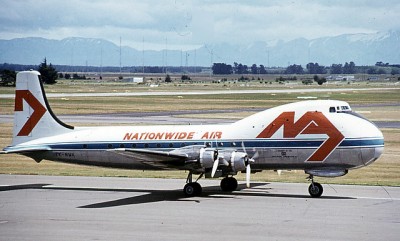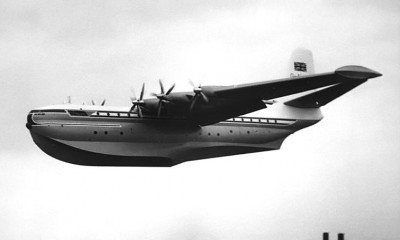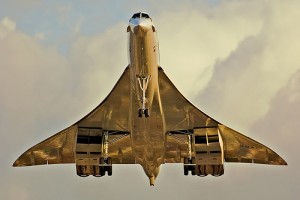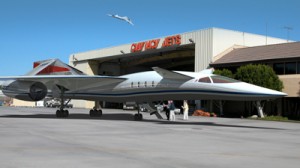
Nationwide Air Aviation Traders Carvair (ZK-NWA) in Christchurch in 1977
What would you get if a DC-4 made love to a Boeing 747-100 Freighter and they had a child? You would get one interesting looking Aviation Traders Carvair that’s what.
Actually the birth of the Carvair came more from an abundance of left over DC-4’s and a need to replace aging Bristol 170 Freighters used in car ferrying services. They weren’t just getting older, but cars were getting bigger and a larger a aircraft was needed to keep the car ferrying business profitable.
Car ferrying service was popular between England and the rest of Europe. An aircraft was needed that was able to reliably cross the channel while holding enough cars and passengers to be profitable. In the late 1950’s airlines started replacing prop aircraft, like the DC-4, with jet powered Boeing 707s and DC-8s.
To convert the old DC-4s wasn’t too difficult and was relatively inexpensive. They would take the cockpit, raise it and create an upperdeck. Unlike the Bristol 170s which only held three cars and 20 passengers, the Carvairs were able to carry five cars with 25 passengers.
The first Carvair flew on June 21, 1961 and 21 of the aircraft were built. Eight of those aircraft ended up crashing out of their lifetime in different parts of the world. One of the Carvairs, N89FA is based in the US and according to FlightAware she last flew in January 2010.
More good stuff to check out:
* Photos of Aviation Traders Carvair on Airliners.net
* Google maps shows a crashed Carvair in Alaska
* Great website about the Carvair
* Old advertisements on the Carvair’s service
* Video of Carvair

Saunders Roe Princess G-ALUN flypast at the Farnborough SBAC Show in September 1953
In the first half of the 1900’s airline travel boomed. During World War II, there was a shortage of materials for making aircraft and proper runway facilities. Because of a lack of proper airports, the popularity of flying boats soared (get it soared?). Flying boats were purpose-built to land on the water and provide air transportation for all over the work (as long as water was around).
The 1940’s saw the biggest use of flying boats to get passengers around the world, but by the beginning of the 1950’s, more and more land based aircraft were being used.
The Saunders-Roe Princess was one of the last flying boats designed and built, but it never made it into service. Her journey started in 1945 when Saunders-Roe wanted to build an aircraft that could used by British Overseas Airways Corporation (BOAC). Their bid was successful an in 1946 three aircraft were ordered by BOAC.
Engineers decided to have the airplane powered by ten turboprop engines. The four inner propellers had contra-rotating propellers, driven by a twin engine. The two outer propellers were single and powered by one engine. Although the engines were unique and head of their time, the complexities ended up dooming the aircraft type. The total thrust was not as they had expected and the gearing was not able to handle the engines.
The Princess was a double decker plane, designed to fly 105 passengers very comfortably. The aircraft was to be the pinnacle of flying boats, but it never got to see that day. In 1951 BOAC cancelled their orders. NASA looked at using the aircraft for transporting Saturn V rocket parts, but decided against it. Airbus even looked at using the Princess to transport A300 sections, but decided on the Super Guppies instead. There was hope the aircraft would be used in some capacity, but never were. In 1967 all three were destroyed.
Seeing such a beautiful plane destroyed is a real shame. One could have found its way to a museum or into a collector’s hands.
Additional media:
* Old video on making the Saunders-Roe Princess
* Airshow fly by of the plane
* Some color video and seeing her twin blades
* A few photos from Airliners.net
* Article on the aircraft written in 1952 by Flight
Image: RuthAS via Wikipedia

British Airways Concorde landing at Heathrow in 2003.
When the TU-144 and Concorde first went into service in the 1970’s , it was a time of aviation excitement. Both aircraft had the promise to completely revolutionize commercial transportation, providing speeds over twice the speed of sound (around 1100 mph vs 500-600 mph for other commercial airliners). Most thought the supersonic transport (SST) would replace other aircraft, to become the norm in general aviation. It was thought the sonic boom experienced when a jet goes over the sound barrier would become part of daily life, and people would be willing to live with them to have fast transportation.
The Tupolev TU-144 was the first SST to take flight in December 1968, two months before the Concorde. The TU-144 hit a big setback when the first production aircraft crashed during the 1973 Paris Air Show, killing all six crew members aboard and 15 people on the ground. Then in 1978 another TU-144 crashed during a pre-delivery test flight, killing all aboard. The aircraft type flew 55 passenger flights with Aeroflot before it was pulled from service in June of 1978, less than ten years after its first flight.
At the time Boeing was also working on their own SST, the Boeing 2707. The US didn’t want Europe and Russia to have the monopoly on SST technology, so the US government funded a contract for Boeing to study making its own. In 1963 the National Supersonic Transport program subsidized 75% of development costs to help Boeing directly compete with the TU-144 and Concorde. Since the Concorde and TU-144 were almost twins, Boeing wanted to make something different and were aiming to make a 250 passenger SST, which would hold about twice the passengers of the other two. In March 1971, funding for the project was canned by Congress and although private funding was able to raise nearly $1 million, the entire project was shut down in May of 1971. At the time, the Boeing 2707 had 115 orders from 25 airlines and the Concorde only had 74 order from 16 customers.
The Concorde and Tu-144 might have looked similar, but Arospatiale-BAC’s Concorde was superior in its avionics and capabilities. It has its first flight in March of 1969 and entered service in 1976. During that time, the first two prototypes traveled the world to build excitement and there were 70 orders for the plane. However, many orders were canceled after an oil crisis caused financial difficulty for the airlines, the crash of the similar TU-144, and concerns about the sonic-boom not being acceptable in populated areas. In the end, only British Airways and Air France took delivery of the Concorde. The plane was flown until 2003 when Air France flight 4590 crashed in France killing all 109 people aboard and raising questions about the safety of the aircraft. The aircraft was retired on November 26, 2003.

Supersonic Aerospace International's QSST rendering.
There was hope in the early 90’s for a resurgence of SST when a wealthy businesswoman, Judith DePaul, worked with Tupolev and NASA to use a TU-144 as a testbed for additional SST research. Over $350 million was spent on retrofitting the mothballed Tu-144 and it made a total of 27 flights through the 90’s, but was canceled in 1999 for “lack of funding.” Today, the aircraft is rusting away in storage with little hope of being used again.
It has been over 40 years since the first SST flight occurred and almost 6 years since the last SST commercial flight. It has seemed unlikely there will be a revival of the Concorde or TU-144, but there might be hope on the horizon. The biggest hurdle has been the sonic-boom heard when an aircraft passes the sound barrier. The loud and disruptive boom caused previous SST’s to be flown only over water. Scientists are currently working on ways to “shape” the boom, making it sound more like distant thunder, something that the general public could live with to allow flights over land.
Even if the technology becomes available, it is not going to be cheap. A round trip ticket from New York to London on the Concorde before its cancellation ran about $10,000.00 USD. However, history has shown new technology can be expensive at first but as it develops can become more cost effective. The Concorde didn’t have time to become less costly since the technology became stagnant.
It would be a long while before Boeing or Airbus would start seriously considering making a SST line of aircraft. But smaller business jet companies are spending good sums of money researching new technology that is being dubbed Quiet Supersonic Transport (QSST). Supersonic Aerospace International is working on creating the next generation of SST starting in the business jet realm. They are hoping to have their first aircraft flying by 2014 with first customer delivery in 2016. Even if they wouldn’t be able to make those optimistic goals, it seems like there would be a big market for business people being able to save time while in-flight around the world.
Who knows where the future will go for SST? Will the start of space travel help in the development in the next SST? I would think there might be some overlap. There are those that already talk about post-SST and moving to hypersonic flight , but that is going to be far out in the future. It seems it might be most beneficial for the technology to start on a smaller scale. It looks like smaller companies might create SST business jets and allow the wealthy to help pay for the development of the technology. As the technology grows, becomes more accepted and less costly, larger aircraft manufacturers could pick up the production of SST aircraft and usage would spread.
Images:
Concorde (Spencer Wilmot)
QSST (SAI)

Boeing 747-300 TriJet concept
During the 1970’s Boeing wanted to better compete with the DC-10 and L1011. The Boeing 747SP was too costly to directly compete, so for a short while, Boeing looked at creating a 747 with three jets instead of the standard four. The design has two jets on the wing and one on the tail in an “S” configuration, much like the L1011. The concept was scrapped since it would take too much time, money, and a new wing design.
Image: Rosboch.net




